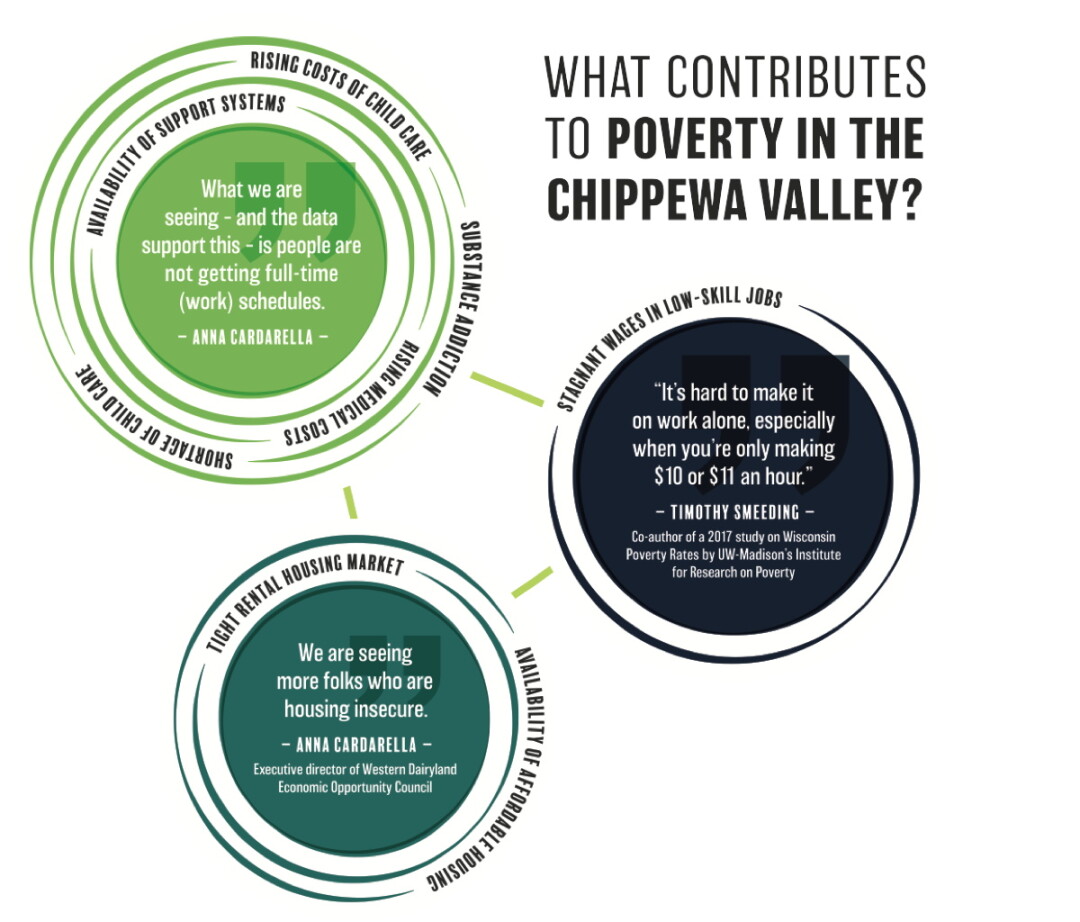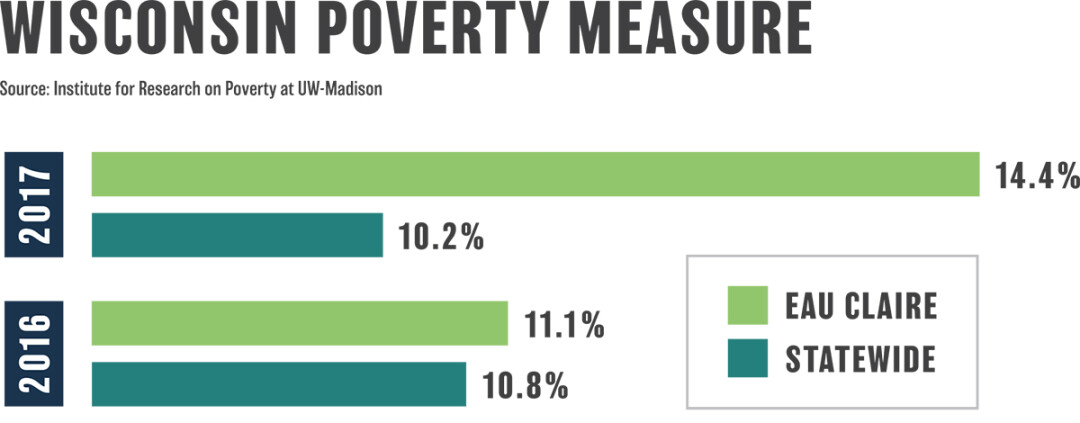The Local Poverty Puzzle
local poverty rates are among the worst in the state, but the reasons why aren’t exactly clear
While the overall poverty rate is falling in Wisconsin, the Chippewa Valley is one of only two areas of the state where the share of people in poverty is significantly above the state average, a new study concluded.
According to a report released in June by UW-Madison’s Institute for Research on Poverty, Wisconsin’s poverty rate fell from 10.8% in 2016 to 10.2% in 2017. However, the Wisconsin Poverty Measure was 14.4% in Eau Claire County and southern Chippewa County. The only area in the state with a higher poverty rate was Milwaukee County, where the rate was 17.2%.
Overall, the state’s poverty rate was essentially unchanged since 2010, which the study’s authors suggest shows the state has been “treading water” throughout the economic recovery.
“It’s hard to make it on work alone, especially when you’re only make $10 or $11 an hour,” said co-author Timothy Smeeding, a professor at UW-Madison’s La Follette Institute of Public Affairs. Smeeding cited several factors – including stagnant wages in low-skill jobs and rising costs for child care and health care – for persistent poverty levels in Wisconsin. However, he said, there was no clear reason why the Eau Claire area rose to the top of the rankings.
The leader of a nonprofit agency that operates anti-poverty programs in west-central Wisconsin agreed that there aren’t easy answers to Eau Claire’s rising poverty rate. “Honestly, I don’t know,” said Anna Cardarella, executive director of Western Dairyland Economic Opportunity Council, which is based in Independence. “I don’t have a crystal ball to show me why Eau Claire and Chippewa counties are higher.”
MULTIPLE FACTORS
And, while Cardarella was surprised to learn of the Eau Claire area’s high ranking, she said that Western Dairyland staff members who work in Eau Claire were not. They suspect a number of factors are at work, including rising medical costs, relatively low wages, an ever-tightening market for rental housing, a shortage of child care, and the difficulty in obtaining consistent, full-time work schedules. The impacts of opioid addiction also likely plays a role, Cardarella said, as does the presence of shelters and other social service agencies in Eau Claire, which might draw people living in poverty in rural areas to the city.
Among the biggest factors in the rising tide of poverty in Eau Claire is the relative lack of affordable housing, Cardarella said. “As far as housing, it’s worse, and we are seeing more folks that are housing insecure,” she said. In Eau Claire County alone, she said, her agency has a list of 180 single homeless people waiting for housing as well as 47 families without homes. And depending on the definition of homelessness you use – for example, if people who are “couch surfing” or living temporary with relatives or friends are included – the figures grow considerably.
Wages are also not keeping pace with the rising cost of caring for a family, Cardarella said. “What we are seeing – and the data support this – is people are not getting full-time schedules,” she said. People are often working multiple jobs to make ends meet, she said, which can also make obtaining child care more difficult.
STATE VIEW
About a decade ago, Smeeding and his colleagues at UW-Madison’s Institute for Research on Poverty created their own metric – the Wisconsin Poverty Measure, or WPM – in an attempt to more accurately account for poverty in the state. Unlike the official poverty measurement tabulated by the U.S. Census Bureau, the WPM takes into account taxes, refundable tax credits, and anti-poverty benefits such as food and housing assistance. It’s also adjusted for Wisconsin’s lower cost of living. In general, the WPM shows poverty in the state to be slightly lower than the official federal poverty measure suggests. The most recent report also found that child poverty was lower and elder poverty was higher than indicated by federal statistics.
According to the report, some parts of the greater Chippewa Valley fared better than the immediate Eau Claire area. “A full 27 of 72 total Wisconsin counties found their poverty rates below the state average by a significant amount,” the report stated. These above-average areas include Dunn, Pepin, Buffalo, Trempealeau, Jackson, and St. Croix counties.
“These findings suggest that the economy is not benefitting workers and families evenly across our state,” said Smeeding, who co-authored the report with Katherine A. Thornton. “I’ve been conducting this study for 11 years now and I have to say, after more than eight years of nationwide recovery from the end of the Great Recession through 2017, we should see better poverty outcomes.”
The report cites Wisconsin’s comparatively low minimum wage as a factor in the poverty rate. That wage in Wisconsin – $7.25 an hour – is equal to the federal minimum wage, whereas 29 other states and the District of Columbia have wages higher than the federal minimum. (These states include three of Wisconsin’s border states: Minnesota, Illinois, and Michigan.)
In addition, Smeeding said, the state’s failure to accept federal funds to expand Medicaid coverage for low-income Wisconsinites also have an impact on poverty. According to The Associated Press, Wisconsin is one of only 14 states to turn down federal Medicaid-expansion funding, and has missed out on $1.1 billion.
While the report found that safety-net programs – such as tax credits, food assistance, and housing programs – helped reduce poverty rates, it also concluded that the positive impact of these programs is shrinking even as wages are stagnating. “Because we believe that the long-term solution to poverty for the able-bodied non-elderly is a secure job that pays well, not an indefinite income support program, these findings are discouraging,” the report state. “New problem areas, such as the rising costs of child care and medical care, are becoming more widespread and offsetting the economic and job recovery in our state, despite our low unemployment rate.”
To read the full report and learn more about poverty in Wisconsin, visit www.irp.wisc.edu.






















